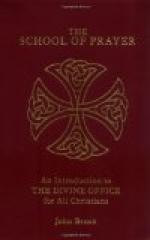Before the canticle are said the opening words of the antiphon, “Salva nos”; and it is repeated in full at the end. “Save us, O Lord, while we are awake, and guard us when we sleep, that we may watch with Christ and rest in peace.”
The prayers, Kyrie eleison, Christie eleison, etc., are said always except when a double office or a day within an octave has been commemorated at Vespers. The prayer, Visita quaesumus is found in Breviaries of the thirteenth century and was introduced probably by the Friars Minor. The words habitationem istam are said to indicate that it is a prayer not only for the chapel of the friars, but for their dwellings on journeys. It was said in choir by the abbot or presiding priest. Like all prayers for Compline it begs God to drive far away the snares of the enemy; it begs Him to let His angels dwell in that house to keep the dwellers therein, in peace; and finally, it begs Him to “let Thy blessing be always upon us. Through Jesus Christ, Thy Son, our Lord, Who liveth and reigneth with Thee in the unity of the Holy Ghost, God, world without end. Amen.”
After the Dominus vobiscum and its response, the abbot or presiding priest gave the solemn blessing “Benedicat et custodiet..., May the Almighty and merciful Lord, the Father, the Son and the Holy Ghost, bless and preserve us. Amen.”
Then one of the anthems of the Blessed Virgin Mary is said. From the Saturday before Advent until the feast of the Purification, inclusive, is said the anthem “Alma Redemptoris Mater”; translated by Father Caswall, it reads:—
“Mother of Christ,
hear Thou thy people’s cry,
Star of the deep
and portal of the sky,
Mother of Him
who Thee from nothing made,
Sinking we strive
and call to Thee for aid.
Oh, by that joy
which Gabriel brought to Thee,
Thou Virgin first
and last, let us Thy mercy see.”
The Latin hexameters are attributed to Hermanus (circa 1054). It has been translated by several poets great and small, and is well known in Newman’s translation, “Kindly Mother of the Redeemer.” It was a popular hymn in Norman Ireland and in Catholic England, as we see in Chaucer’s “Prioress’s Tale.” After this anthem are said its versicle, response, and prayer Oremus, Gratiam tuam quaesumus.
From the first Vespers of the Nativity, the versicle, response and prayer said are “Post partum ...; Dei Genetrix.... Oremus, Deus qui salutis.” ... From the end of Compline on February 2nd until Holy Thursday exclusive the antiphon is “Ave Regina coelorum.” It appears to be of monastic origin, and St. Jerome attributes it to St. Ephraem. Its expressions are borrowed from the works of St. Ephraem, of St. Athanasius and of other doctors, and its theme is Mary, as Queen of Heaven, the dawn of our salvation, and an extolling of her beauty.




